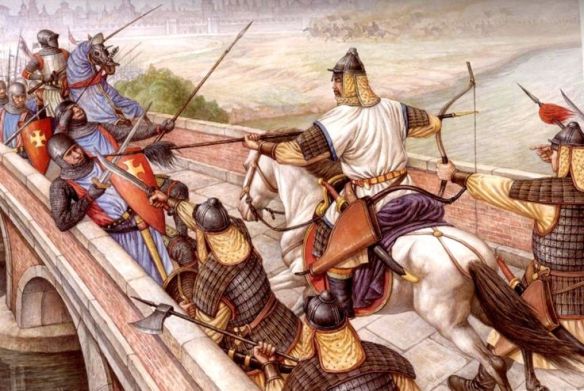
The Battle of Mohi (Muhi), 11 April 1241, was the main battle between the Mongol Empire and the Kingdom of Hungary during the Mongol invasion of Europe. It took place at Muhi, southwest of the Sajó River. After the invasion, Hungary lay in ruins. Nearly half of the inhabited places had been destroyed by the invading armies. Around 15–25 percent of the population was lost, mostly in lowland areas.
Territorial divisions in Eastern Europe in the thirteenth century (at the time of the Mongols).
In a marked departure from Western European practice, the distribution of royal property in Hungary was permanent and hereditary, not given in fief and therefore not tied to the vassal system. These donations created a new class of great barons, without reciprocal obligations to either the royal donor or to the people who became their dependents. Numerous castles and their surrounding villages, even entire counties, were bestowed on the most deserving or clever royal servants. András II also faced criticism for entrusting fiscal affairs to foreigners. Malcontents formed a league and succeeded in extracting from the court a charter of noble freedoms. The Golden Bull of 1222 (somewhat like the English Magna Carta) enshrined the right of nobles to resist royal power. András’s successor, Béla IV, initially tried to backtrack in order to undertake more fundamental and considered reforms than his father. The event that changed his mind was the Mongol invasion.
After Chinghis Khan’s death in 1227, his successor, Ogoday, sent Batu of the Golden Horde to conquer Russia. The immense project achieved, Batu’s army invaded Poland and Hungary. In 1241 the Mongols easily defeated the Hungarians at Muhi. The following winter they crossed the Danube and pursued the king all the way to the Dalmatian islands. The next spring the Mongols suddenly withdrew (whether in response to the death of their great khan or for some unknown motive), leaving behind a destroyed Hungary. The king’s reconstruction efforts opened the way to a new era. Béla IV had to start from scratch, so he first reorganized his military forces and the state administration. He proceeded to create a feudal Christian state, giving great power to loyal barons. All high governmental, legal, commanding, and administrative offices in large territorial units were entrusted to barons and bishops. The result proved positive, as Béla’s reconstruction soon put the country back on its feet. In subsequent centuries, descendants of these barons would contribute to the weakening of the state, but during this crucial period of renewal, Béla’s trust proved well placed. He fortified towns and built new ones, combining military defense with urbanization and the promotion of civic privileges. He laid the foundations of Buda, the castle and the town, making it into an important trade center.
The towns, with their stone churches and houses, markets, municipalities and their inhabitants—many of them foreigners in various trades—generated new wealth for the artisans and tradesmen, and became civilizing centers. Reliable currency (coins with a high silver content) stimulated economic and commercial activities and fiscal income via domestic taxes and duties. Hungary exported beef, wine, and salt and imported cloth, silk, and spices from Venice, Germany, and Moravia. Taxes were fixed according to market conditions. Royalties from the mines (silver, gold, salt) were divided between the treasury and the new entrepreneurs. The new economic activities generated more revenue than the old taxes. Some regions still paid in kind, and the country’s Jews paid collectively, in silver. Few were exempt. With 2 million inhabitants, Hungary was more populous than England, but it still had room for many more people. Béla invited a variety of new settlers. Religious institutions were strengthened. Bishops also provided civil governance over their estates and population, which included the clerical nobility, their servants, and soldiers settled on their land by the bishop. High clergy also had judiciary powers and sat on the Royal Council. The king respected tradition while maintaining control over nominations, retaining investiture for his faithful prelates. Béla’s efforts however were almost entirely negated by his son, István II.A bold military leader, he turned against his father, defeated him, and proclaimed himself “king-junior” over the eastern half of the country. The reign of István’s son, László IV (1272–1290), ten years old when he succeeded his father, was punctuated by intrigue and chronic instability. The lords of the realm pursued their private wars according to the rules of feudal anarchy. Twenty or so among them seized vast tracts of land, spoils, and positions. With the death of András III in 1301, the lights of the House of Árpád went out.
#
After a brutal, but short, invasion by Mongols in 1241, Hungary’s kings welcomed the migration of Germans into its northern district. These immigrant settlements acted as buffers against future aggression into the sparsely inhabited regions of Slovakia. Foreign settlers also helped repopulate areas that had been devastated by the invasions. In addition, Germans brought skills and commercial expertise to the region. Seeking to encourage this migration and also to create a burgher (urban) class beholden to the Crown, Hungary’s monarchs granted special privileges to German colonists and exempted them from control by county officials. Germans also moved into Slovakia’s mining regions where they settled in towns and developed the mining industry. Concentrated in commercial and mining areas, German towns evolved into enclaves governed by special laws.
The practice was followed throughout the rule of the Árpád dynasty, and the influx of foreigners swelled when rulers invited settlers, especially Saxons from German lands, to repopulate regions devastated by the 1241 Mongol devastation. Throughout these centuries, the number of original Slavic and Romanian coinhabitants grew and was augmented by new immigrants, attracted by the wealth and hospitality of the Hungarian land.